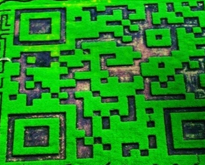Last Updated on March 6, 2024
By slapping a QR code on postcards or receipts or any other printed marketing media, marketers seem to think that they are automatically creating an effective call to action by attracting customers to the company website, thereby engendering brand loyalty. Sorry, but QR codes don’t do everything. They’re just a tool. Like any tool, they require careful application to be used effectively. More often than not, QR codes are used ineffectively by advertisers, which is why websites such as WTF QR Codes exist.
It’s time for companies to rethink their approach to QR codes and realize that these digital forms of advertising must primarily benefit the customer, not the advertiser, in some way. If the QR code is poorly placed or simply not worth the effort of scanning, then it is not successful as an advertising tactic. This article discusses the location of QR codes, making the scan worth the customers’ efforts, aligning QR codes with the right demographics, and setting expectations.
Location. Location. Location.
As in real estate, location is crucial to a successful QR code campaign. Billboards, moving vehicles, flags, television commercials, and subway stations (where cellular service is mostly unavailable) are bad locations for QR codes. At best, they frustrate their viewers. At worst, they inadvertently cause an accident because someone was trying to scan a QR code on a moving bus. Think through the customer’s experience and make sure it’s practical to use a QR code.
Another worthless application of QR codes is online. Why would a user take out their smart phone and scan an image online when they can just click a link? Yet marketers keep making online marketing campaigns that include QR codes.
Instead, think easy to scan. Magazines, flyers, and receipts are some of the best places for QR codes to be. There are certainly plenty of applications of QR codes that are ideal, but make sure the way you’re using them is functional for your customers.
Bottom line: sometimes trendy technology is inappropriate in certain contexts.
Make it worth the effort

(Family’s 309,570 square feet QR code sets Guinness World Record)
If all people get is a company webpage after going through the trouble of scanning a QR code, then they will be disappointed. Further, they may be less likely to make the effort next time. Offer something of value to the customer, such as a coupon, promotion, or detailed product information. At a minimum, make a landing page specific to the QR code campaign so they can see they’ve ended up on the right page.
In addition, direct them straight to what they’re looking for. Customers should get that 50% coupon immediately, not after searching the company homepage. Also, make sure that the site connected to the QR code is mobile optimized. To learn what one customer had to say about an effective QR campaign by Taco Bell, check out this article, which describes an experience in which the customer received everything expected, nothing more or less, as indicated on the copy next to the QR code.
Bottom line: customers should not feel cheated after scanning a QR code.
Know your customers
It’s critical to a QR code campaign’s success that the technology be aligned with the consumer. Not all demographics care to get online and shop. Some simply are not allowed – such as those under 18 without their parent’s permission.
Another point to consider is that QR codes can deliver more than just a URL. You can make a QR code that will provide your contact information, map coordinates, auto-dial a phone number, or even deliver a simple text-based message. Maybe contact information is more appropriate use of a QR code on a business card than taking the customer to a landing page.
Set expectations
Finally, tell your customers what to expect. Most importantly this applies to pre-scanning but also post-scanning when applicable. Tell your customers that they’ll receive a coupon, can find more information, or can call now by scanning the code. This gives your customers a clear set of expectations so they know why they’re scanning and what they’re going to get. As in the Taco Bell survey above, even the landing page made it clear that only four minutes would be needed of their time.
QR codes can be incredibly effective – when applied properly. The problem has been misapplication resulting in mixed or no response rates. But when applied properly and to the right demographic with a clear call to action, QR codes can be a powerful tool for transitioning customers from print ads to your website or other digital marketing materials.
Check out our previous articles!
- Best Laptops for College Students
- Top Ten Over Used Stock Photographs
- How to Start a Business
- Computer Science and Marketing: A Developing Relationship
- Does Midlife Education Improve Skills of your Employees?
We hope you enjoyed this article! Please don’t forget to subscribe to our RSS-feed or follow Inspirationfeed on Twitter, Google+, and Facebook! If you enjoyed the following article we humbly ask you to comment, and help us spread the word!

